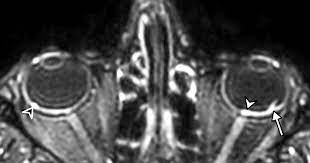Images: www.rsna.org Radiological Society of North America
A small study in France, published February 16, 2021 in the medical journal Radiology, of the 129 patients who were studied with severe COVID-19, who were hospitalized and underwent magnetic resonance imaging (MRI) brain scans across 16 hospitals from March 4 to May 1.
Previous studies have shown ocular manifestations may present in COVID-19 active in 31% of patients. In some cases evidence has been presented with ophthalmic symptoms as the first complaint of patients. COVID-19 has already been linked to cases of conjunctivitis, but this is the first time researchers have noticed nodules on the back of patient’s eyes. Researchers say the viral infection may affect blood vessels which could lead to the nodules. The theory is that the nodules could be related to inflammation triggered by the virus and inadequate drainage of the veins around the eyes due to patients remaining in the prone position, to improve oxygenation, for a significant amount of time.
Of the 129 patients:
- 9 patients (7%) had abnormal MRI findings of the globe, or eyeball. The MRI scans showed one or more nodules in the back part, or posterior pole, of the eyeball.
- 7 of the 9 patients were in the prone position,
- 7 of 9 patients were intubated in the ICU.
- 8 patients had nodules in both eyes.
- 8 patients had spent time in the ICU for COVID-19
- Many of the nine had underlying conditions.
With the first goal of getting CoVid patients able to breathe on their own and reduce the viral load. There may be many others with these nodules not just in the eye but also may have had nodules forming in other parts of the body, but doctors have not known to scan for them. The study had several limitations, like the lack of a control group and samples testing for Covid-19 in the eyes and conjunctiva, or the membrane covering the eye and eyelids.
As with other newly discovered potential side effects of COVID-19, the long-term risks are still being assessed. With such a small sample group having been studied more testing is needed to determine the long-term ocular damage and at what stage of the virus are these manifestations occurring.
#eyegotcha
#PittsburghEyeCare
#PittsburghOptometrist
Sources:






